East Africa Lubricants Market Size
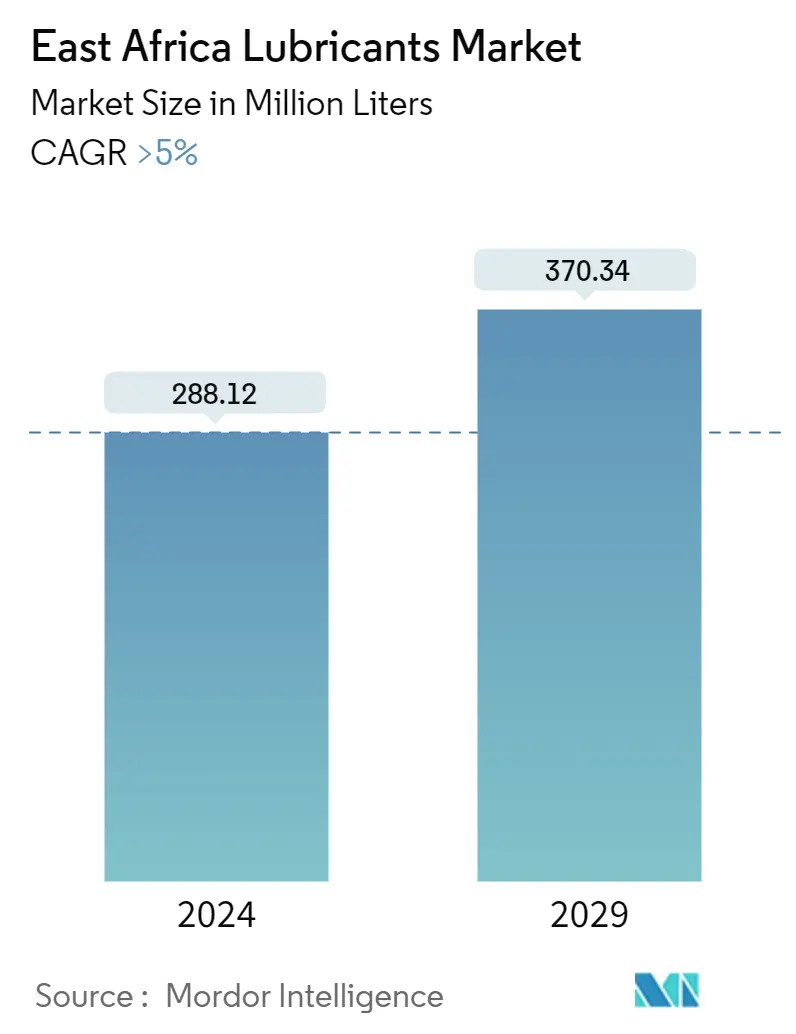
| Study Period | 2019-2029 |
| Base Year For Estimation | 2023 |
| Market Volume (2024) | 288.12 Million liters |
| Market Volume (2029) | 370.34 Million liters |
| CAGR (2024 - 2029) | > 5.00 % |
| Market Concentration | Medium |
Major Players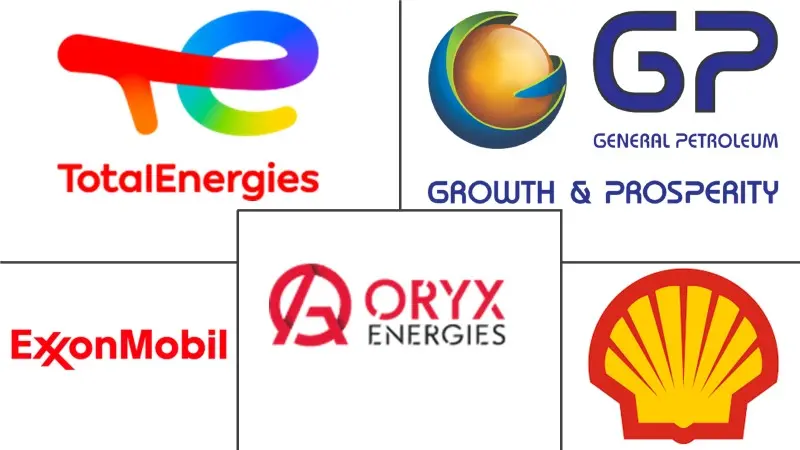
*Disclaimer: Major Players sorted in no particular order |
East Africa Lubricants Market Analysis
The East Africa Lubricants Market size is estimated at 288.12 Million liters in 2024, and is expected to reach 370.34 Million liters by 2029, growing at a CAGR of greater than 5% during the forecast period (2024-2029).
The COVID-19 pandemic negatively impacted the market. COVID-19-related restrictions led to declined maintenance requirements from several industries, such as oil and gas, automotive, metallurgy, etc. The major impact was observed in the automotive industry. Currently, the market has recovered from the pandemic. The market reached pre-pandemic levels in 2022 and is expected to grow steadily in the future.
The rising penetration of used vehicles increases lubricant consumption and has been driving the market growth during the forecast period.
However, volatility in raw material prices and limited base oil production are anticipated to hinder the growth of the studied market.
Moreover, increasing electrification and power addition in the region is likely to provide opportunities for the market over the next five years.
The automotive sector is likely to be the largest end-user owing to the increasing use of vehicles in the country.
East Africa Lubricants Market Trends
Increasing Demand from Automotive Sector
- Lubricant is a fluidic material that is used to reduce friction between contact surfaces to avoid wear and tear. It is prepared with specific additives and specific group base oils depending upon the end-uses. Lubricants in the automotive industry are mainly used as engines, gear, and hydraulic oils.
- Different lubricants used for passenger cars include engine oils, automatic transmission fluids, axle and manual transmission oils, greases, maintenance and additives, brake and steering fluids, coolants and antifreeze, and windscreen fluids.
- Car production in Kenya increased significantly. According to the Kenya National Bureau of Statistics, in 2022, car production in Kenya amounted to 13,473 units, up from 10,096 units. Further, in the first seven months of 2023, the country produced 7,416 units.
- The East African region is considered a hub for innovations in e-mobility. Many local companies in the region are creating business models that aim to fill gaps in transportation services. The companies are focusing on launching new models of passenger buses and two-wheeled motorbikes.
- The growing electric vehicle market in the region is attracting world-leading car companies and local start-ups to establish plants to produce advanced vehicles.
- In June 2022, BasiGo, an early-stage e-mobility start-up in Kenya, launched an electric passenger bus that traveled 250 kilometers on one charge. The electric bus is assembled locally using the parts a Chinese car-making giant BYD designed.
- In March 2022, Tata Motors, an Indian car manufacturer, launched its compact SUV-Tata Nexon in the Tanzanian market. The country's automotive market is fast-growing and expected to boom soon, with many global players launching their models in the market. The primary mode of transportation in the country is the small bus rapid transit (BRT) fleet. The United Nations Environment Programme (UNEP) is helping African cities drive toward soot-free public transportation, including electric-powered buses.
- In July 2023, a Swedish-Kenyan technology company, Roam, opened the largest electric motorcycle assembly plant in East Africa, with an annual production capacity of 50,000 units. The 10,000-square-meter plant offers sustainable transportation solutions for motorcycle taxis operating in the region.
- Hence, the growing automotive industry in the region is anticipated to drive the demand for the lubricants market during the studied period.
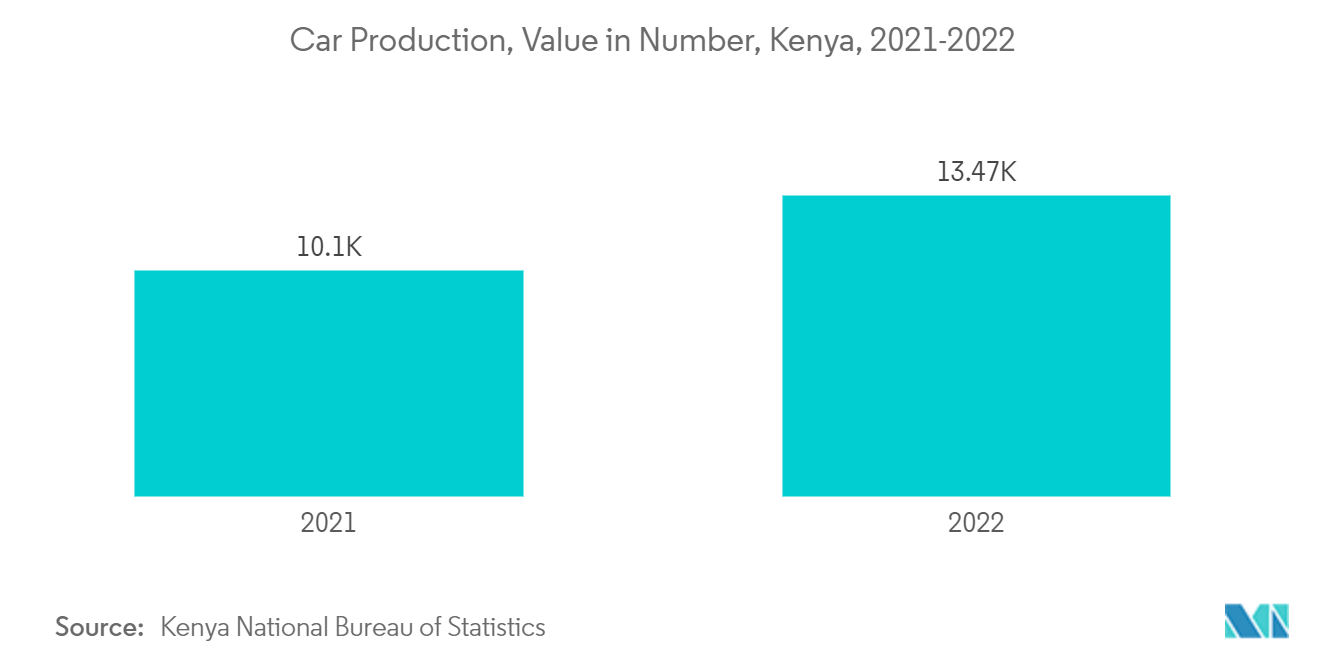
Increasing Demand of Engine Oil in the Region
- Engine oils are composed of 75-90% base oils and 10-25% additives. Engine oils are primarily used to lubricate the moving parts in the engine, such as internal combustion engines. They are typically used for other applications such as wear reduction, corrosion protection, and smooth operation of engine internals.
- They function by creating a thin film between the moving parts to enhance the transfer of heat and reduce tension during the parts' contact. High-mileage engine oils are in demand lately, owing to the properties that help in the prevention of oil leaks and reduction of oil consumption.
- Engine oils find applications in various end-user industries, including automotive, power generation, heavy-duty equipment, construction, and other end-user industries.
- The construction industry employs heavy equipment for various purposes. The industry has been on a growth path in the last few years in the East African region.
- In 2022, the construction sector in Kenya registered a growth of 4.1%, owing to various regulatory environments and developments in infrastructure. According to Kenya's Economic Survey 2023, the number of building plans approved increased by 58%.
- A few major construction aggregate-consuming projects have recently been completed in the region in 2022, such as the USD 9.8 billion Kenya-Uganda-Rwanda-South Sudan rail project and the USD 5 billion Lamu project in Kenya.
- East Africa has resources capable of generating vast amounts of renewable energy, such as wind, hydro, and solar power. This energy is untapped mainly in Tanzania and Uganda, and most of their populations remain unconnected to an electric grid, thereby increasing the demand for lubricants.
- According to the Kenya National Bureau of Statistics, electricity generation in Kenya reached nearly 12,985 gigawatt-hours in 2022, representing an increase of about 4.5% compared to the previous year, thus boosting the market growth.
- Therefore, all the abovementioned factors are going to impact the market studied during the forecast period.
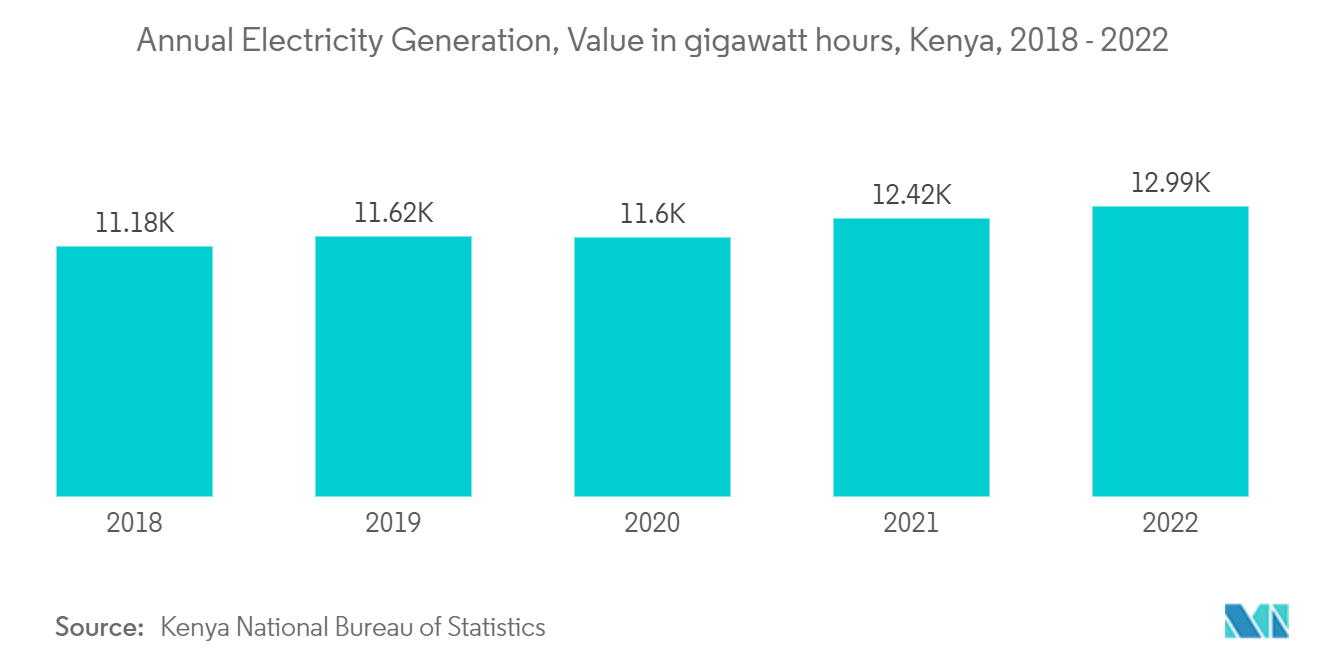
East Africa Lubricants Industry Overview
East Africa's lubricants market is partially consolidated in nature. The major players in the studied market (not in any particular order) include General Petroleum, TotalEnergies, Shell plc, Exxon Mobil Corporation, and Oryx Energies SA, among others.
East Africa Lubricants Market Leaders
-
General Petroleum
-
TotalEnergies
-
Shell plc
-
Exxon Mobil Corporation
-
Oryx Energies SA
*Disclaimer: Major Players sorted in no particular order
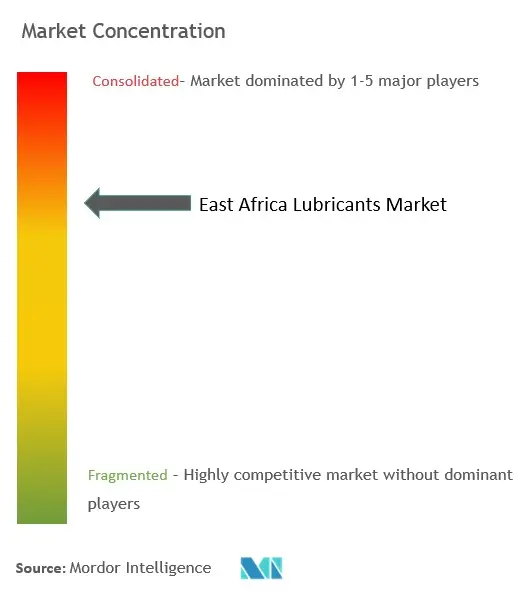
East Africa Lubricants Market News
- February 2023: Engen and Vivo Energy announced a combination of their respective African businesses. Moreover, PETRONAS was to sell its 74% shareholding in Engen to Vivo Energy at completion. This was to create one of Africa’s largest energy distribution companies.
- November 2022: Chevron Corporation launched environmentally acceptable lubricants (EALs) for marine applications. These EALs are made from biodegradable ingredients. The company launched Clarity Synthetic EA Grease 0, which was suitable for a range of marine applications, including rudder carrier bearings, slides, hinges, submerged pumps, and propeller caps.
East Africa Lubricants Market Report - Table of Contents
1. INTRODUCTION
1.1 Study Assumptions
1.2 Scope of the Study
2. RESEARCH METHODOLOGY
3. EXECUTIVE SUMMARY
4. MARKET DYNAMICS
4.1 Drivers
4.1.1 Increasing Demand Due to Industrial and Economic Growth
4.1.2 Rising Penetration of Used Vehicles Increases the Lubricant Consumption
4.1.3 Other Drivers
4.2 Restraints
4.2.1 Volatility in Raw Material Prices and Limited Base Oil Production
4.2.2 Other Restraints
4.3 Industry Value Chain Analysis
4.4 Porter's Five Forces Analysis
4.4.1 Bargaining Power of Suppliers
4.4.2 Bargaining Power of Buyers
4.4.3 Threat of New Entrants
4.4.4 Threat of Substitute Products and Services
4.4.5 Degree of Competition
5. MARKET SEGMENTATION (Market Size in Volume)
5.1 By End User
5.1.1 Automotive
5.1.1.1 Passenger Vehicles
5.1.1.2 Commercial Vehicles
5.1.1.3 Motorcycles
5.1.1.4
5.1.2 Heavy Equipment
5.1.3 Metallurgy and Metalworking
5.1.4 Power Generation
5.1.5 Marine
5.1.6 Other End-user Industries (Oil and Gas, Etc.)
5.2 By Product Type
5.2.1 Engine Oils
5.2.2 Greases
5.2.3 Hydraulic Fluids
5.2.4 Metalworking Fluids
5.2.5 Transmission and Gear Oils
5.2.6 Other Product Types (Compressor Oils, Process Oils, Etc.)
5.3 Geography
5.3.1 Kenya
5.3.2 Tanzania
5.3.3 Democratic Republic of Congo
5.3.4 Burundi
5.3.5 Uganda
5.3.6 Ethiopia
5.3.7 Rwanda
6. COMPETITIVE LANDSCAPE
6.1 Mergers and Acquisitions, Joint Ventures, Collaborations, and Agreements
6.2 Market Share (%)**/Ranking Analysis
6.3 Strategies Adopted by Leading Players
6.4 Company Profiles
6.4.1 BP p.l.c.
6.4.2 Chevron Corporation
6.4.3 China Petrochemical Corporation
6.4.4 Engen Petroleum Ltd.
6.4.5 ENOC Company
6.4.6 Exxon Mobil Corporation
6.4.7 General Petroleum
6.4.8 Hass Petroleum
6.4.9 Lake Group
6.4.10 LIQUI MOLY GmbH
6.4.11 Mineral Oil Corporation Limited
6.4.12 Motul S.A.
6.4.13 National Oil Corporation of Kenya
6.4.14 Oryx Energies SA
6.4.15 Shell PLC
6.4.16 TotalEnergies
- *List Not Exhaustive
7. MARKET OPPORTUNITIES AND FUTURE TRENDS
7.1 Increasing Electrification and Power Addition in the Region
7.2 Other Opportunities
East Africa Lubricants Industry Segmentation
Lubricants are substances made from a combination of base oils and additives. These lubricants are used in various automotive applications such as engines, brakes, gears, and other parts lubrication. The base oil composition in the formulation of lubricants is primarily between 75-90%. Lubricants are used to reduce friction between surfaces in contact to minimize energy loss generated from friction.
The East African lubricants market is segmented by end-user, product type, and geography (Kenya, Tanzania, the Democratic Republic of the Congo, Burundi, Uganda, Ethiopia, and Rwanda). By end-user, the market is segmented into automotive, heavy equipment, metallurgy and metalworking, power generation, marine, and other end-user industries (oil and gas, etc.). By product type, the market is segmented into engine oils, greases, hydraulic fluids, metalworking fluids, transmission, and gear oils. The report also covers the market size and forecasts for the market in 7 countries across the region.
For each segment, the market sizing and forecasts have been done on the basis of volume (liters).
| By End User | |||||
| |||||
| Heavy Equipment | |||||
| Metallurgy and Metalworking | |||||
| Power Generation | |||||
| Marine | |||||
| Other End-user Industries (Oil and Gas, Etc.) |
| By Product Type | |
| Engine Oils | |
| Greases | |
| Hydraulic Fluids | |
| Metalworking Fluids | |
| Transmission and Gear Oils | |
| Other Product Types (Compressor Oils, Process Oils, Etc.) |
| Geography | |
| Kenya | |
| Tanzania | |
| Democratic Republic of Congo | |
| Burundi | |
| Uganda | |
| Ethiopia | |
| Rwanda |
East Africa Lubricants Market Research FAQs
How big is the East Africa Lubricants Market?
The East Africa Lubricants Market size is expected to reach 288.12 million liters in 2024 and grow at a CAGR of greater than 5% to reach 370.34 million liters by 2029.
What is the current East Africa Lubricants Market size?
In 2024, the East Africa Lubricants Market size is expected to reach 288.12 million liters.
Who are the key players in East Africa Lubricants Market?
General Petroleum, TotalEnergies, Shell plc, Exxon Mobil Corporation and Oryx Energies SA are the major companies operating in the East Africa Lubricants Market.
What years does this East Africa Lubricants Market cover, and what was the market size in 2023?
In 2023, the East Africa Lubricants Market size was estimated at 273.71 million liters. The report covers the East Africa Lubricants Market historical market size for years: 2019, 2020, 2021, 2022 and 2023. The report also forecasts the East Africa Lubricants Market size for years: 2024, 2025, 2026, 2027, 2028 and 2029.
East Africa Lubricants Industry Report
Statistics for the 2024 East Africa Lubricants market share, size and revenue growth rate, created by Mordor Intelligence™ Industry Reports. East Africa Lubricants analysis includes a market forecast outlook to for 2024 to 2029 and historical overview. Get a sample of this industry analysis as a free report PDF download.



